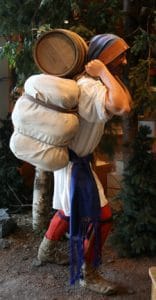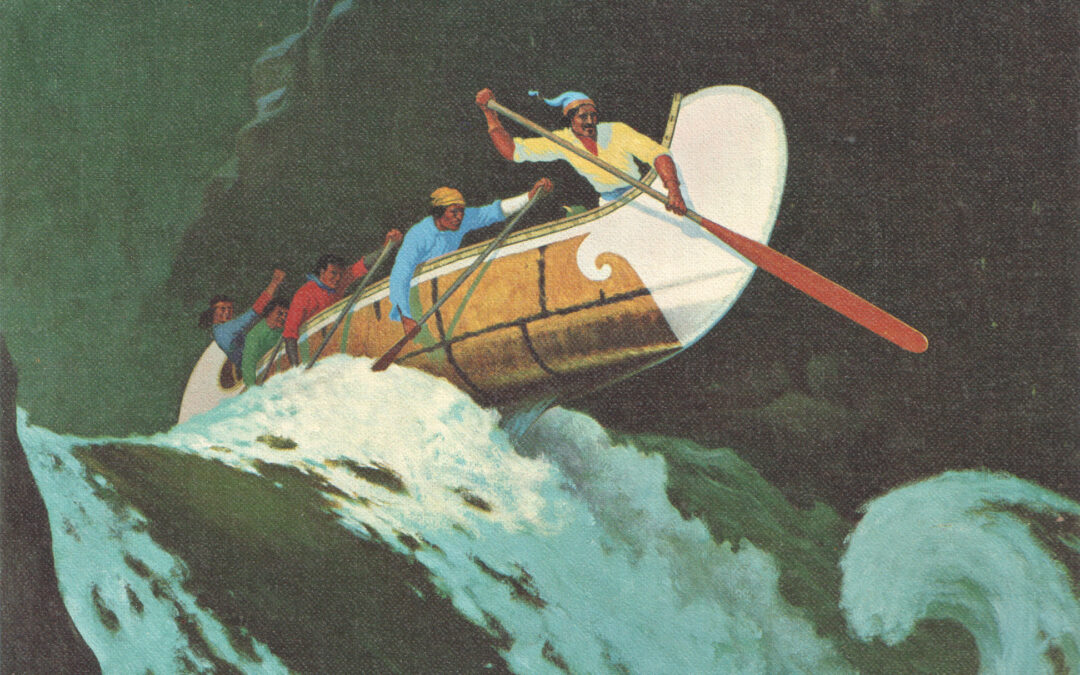“A Canadian, if born to be a labourer, deems himself to be very unfortunate if he … shall reach five feet ten or eleven, it forever excludes him from the privilege of becoming voyageur. There is no room for the legs of such people in these canoes, But if he shall stop growing at about five feet four inches, and be gifted with a good voice, and lungs that never tire, he is considered as having been born under a most favourable star.” ~Thomas I. McKenney, written in 1825

A short voyageur at Forts Folle Avoine.
McKenney further describes the pride of profession: “The voyageur was class-conscious: he considered himself favored by fortune to belong to his group; he took a happy pride in doing his work in such a way to bring credit to his fellow workers; and he considered the toil and hardships of his chosen work incidental to the profession and was seldom known to pity himself.”
So, what is a voyageur?
Short answer: Think of the word “voyage” — a trip. In French, a person taking a voyage is a “voyageur.”
Wait, there’s more. Voyageurs were French-Canadian canoemen who traveled about 1,200 miles, from small villages around Montreal, Quebec, Canada, to Grand Portage (on the Minnesota side of Lake Superior) — and back — or onward.
But voyageurs didn’t travel to enjoy an interesting tour — they paddled birchbark canoes jam-packed with 3 tons of trade goods most of those miles. Where they couldn’t paddle, they either towed the loaded canoe through shallow rocky rivers or they carried the trade goods and supplies on their backs over a portage. They were like an “engine” for a truck. Even so, as McKenney points out, they remained undaunted by the impossibility of their tasks, squaring their shoulders and proudly saying “Je suis un voyageur” when yet another impossible task was demanded of them.

“Canadian Express” by Arthur Henry Howard Heming (courtesy of Wikimedia Commons)
An engagé, a person who was“engaged,” or hired, as a canoeman, is a synonym for voyageur.
In an economy with few career options. this job was at the lowest level in the fur trade. In those times, employment included farmer (if a family had land), blacksmith, wheelwright or carpenter (if a father had those skills). Being a voyageur was often a family tradition for large families — or poor ones.
Requirements for voyageurs
- Age — variable. Most started about age 16-18, when they had developed enough arm and back strength. A rare few signed on as early as 11. A man probably ended his career after a decade, if his body was too impaired by the intense physical effort — hernias were common — or if he’d saved money. Grace Lee Nute wrote of one voyageur who’d worked 24 years as a canoeman, and 41 years in service!
- Short — Paddlers under 5’4” preferred, up to 5’6” accepted.
- Stamina — Men paddled pre-dawn to sunset, most days, stopping only for breakfast and dinner and for short breaks to smoke. They paddled about 4 miles per hour.
-

Voyageurs disliked portaging. Grand Portage Interpretive Center
Strong — Each man was responsible for 6 90-pound parcels of trade goods or provisions. Voyageurs usually carried 2 parcels at a time over portages (if a man liked proving himself of showing off, he carried more parcels).
- Paddling skill — Most were middlemen (milieux). A bowman (devant) and steersman (gouvernail) were paid more (up to 1,200 livres) and received more tobacco.
- Cooking or singing — These skills could earn a man extra wages.
- Adventurous — Willingness to live away from their families, travel to places they’d never heard of, sleep under a canoe, run rapids, live and trade among the natives.
- Obedient — Men were assigned sides of the canoe and places to paddle. If his shoulder hurt, he couldn’t just swap with his “seatmate.” He had to be willing to work long hours, in uncertain weather, always protecting the cargo before his own life.
Skills NOT needed:
- Computation and writing — Most voyageurs were illiterate; their contracts were read to them and they signed with an “X.” [In Book 1, André ‘s foster father uses the boy’s schooling to get him a slot in the canoe, so he can assist the brigade leader who’s not handy with keeping fur trade records.]
- Swimming — surprisingly, most voyageurs couldn’t swim. [André learns how in Book 2, and teaches his canoemates in Book 3! ]
Pay

“Ancient Canadian” by Philllipe Gaspe
Contracts were signed for different lengths of terms: a half-year from early May to late September (porkeaters) and up to five years (winterers or hivernants). Winterers lived at small posts dotting the hinterlands of the continent — in the spring they’d transport the tons of furs they’d amassed to the summer rendezvous, a half-way place to gather.
They were paid in “room and board,” — food along the way plus a blanket, clothing (shirt and trousers, handkerchiefs), tobacco and wages (roughly 400 livres per season). Those elements depended on the contract they’d signed (half-year to five years). If they’d opted for a longer term, they’d receive a second blanket and set of clothes and more tobacco.
How many jobs were available?

Three porkeaters signed on in 1786, all with the same name in the same brigade. One paddled devant (bowman) and the others as milieux (middlemen).
Nute estimates that in 1777 there were 2,431 voyageurs listed on licenses leaving from Montreal and Detroit. That didn’t include the winterers already in the interior and the Hudson’s Bay Company employees, bringing the total to a conservative estimate of 5,000. And the trade continued to grow in the next 25 years.
Dr. John J. Bigsby, secretary of the commission that marked out the international boundary between Canada and the United States, wrote about the voyageurs who paddled his express canoe at Lachine:
“I was disappointed and not a little surprised at the appearance of the voyageurs. … here they were a motley set to the eye: but the truth was that all of them were picked men, with extra wages as serving in a light canoe.”
Was there job improvement in the fur trade?
A very astute voyageur might become an interpreter or guide. [Andre’s brigade leader Antoine was both guide and interpreter.]
-

Rene Bourassa (not to scale) is the larger-than-life voyageur at Crane Lake.
Interpreter: An experienced interpreter spoke French, some English and various Indian dialects in areas where they traveled through. He needed to interact with nearby Native American tribes learn about route information or trade for food or replacement moccasins.
- Guide: Guides knew all the routes, rivers and problem areas. A guide likely also had significant experience in trading with various tribes and was comfortable speaking other Native languages.
In the 1690s, voyageurs began traveling to trade furs across French Canada; the era ended in the 1850s.
Nute said: “Though he is one of the most colorful figures in the history of the great continent, the voyageur remains unknown to all but a few.”
Or, seeing as you’ve gotten this far, maybe voyageurs will be better known.
Sources
- “The Voyageur” by Grace Lee Nute. Minnesota Historical Society (St. Paul, 1987)
- Sketches of a Tour to the Lakes, of the Character and Customs of the Chippeway Indians …” by Thomas I. McKenney. Bureau of Indian Affairs (Baltimore, 1827)
- “The Shoe and Canoe or Pictures of Traveling the Canadas” by Dr. John J Bigsby. (London, 1850)
- Wikipedia: Voyageurs
Final Thoughts
- Read about all the things that could happen to a brigade in these well-researched novels about voyageurs in the early 1800s. They follow too-young Andre (mentioned above) in Book 1 — “Waters Like the Sky” and Book 2 — “Treacherous Waters” and Book 3 — “Uncharted Waters,” all in paperback and ebooks.
- Subscribe to this blog and read posts as they are published!
- For what I’m researching or quirky discoveries, visit me on Facebook or Instagram (@nlnlnraj): I love your comments.
- Book me as a speaker.
- Ask your library, local school, gift shop to buy copies.
- Be a voyageur for an hour—come to one of my presentations. Next is “Women in the Fur Trade” for the Morrison County Historical Society in Belle Prairie, Minnesota, on Sept. 25
- Consider writing fan fiction — your own chapter about what else could happen.
- Create an emoji ͼ!¡¡¡¡¡¡¡!ͻ
What I’m currently reading:
“Fur Trade Nation: An Ojibwe’s Graphic History” written and illustrated by Carl Gawboy (AnimikiiMazina’iganan: Thunderbird Press, Cloquet, Minnesota, 2025)
“Our Story of Eagle Woman: Sacagawea, They Got it Wrong” by the Sacagawea Project Board of the Mandan, Hidatsa and Ariakra Nation The paragon Agency, Orange, California, 2021)




My fathers family were the Mayeux’s and LaBrie’s, Doucettes and Trembleys. All from small towns in Quebec and eventually moved to Belle Prairie….. Interred in the history of movement from Canada
Me too. And they’re hard to trace. In my family, the Peletiers settled in the Centerville/Little Canada area, and then a Peloquin arrived, and married a Peletier.
But I wonder why they left, how they got here, and so many other questions that I can’t answer. I’ll be at Belle Prairie on Sept. 25, talking about Women in the Fur Trade: (There Were Some?)–I hope to meet you then.